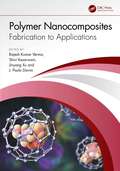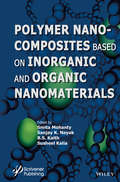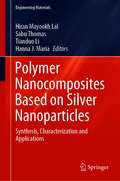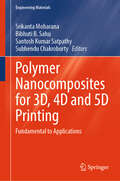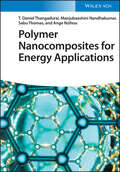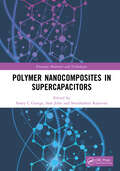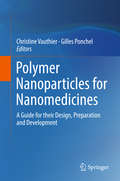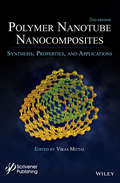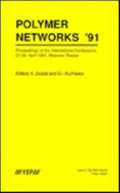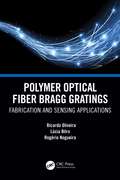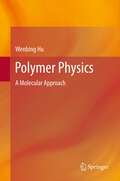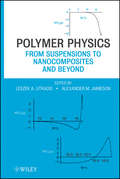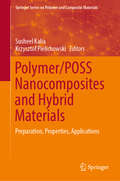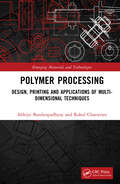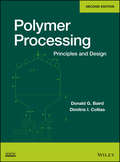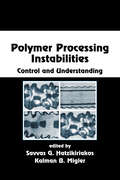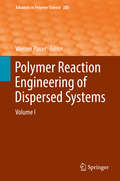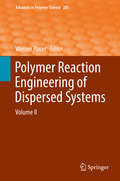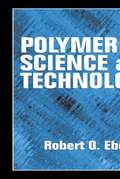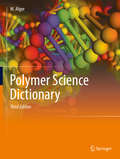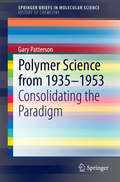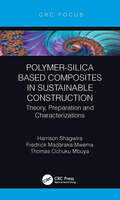- Table View
- List View
Polymer Nanocomposites: Fabrication to Applications
by Rajesh Kumar Verma Shivi Kesarwani Jinyang Xu J. Paulo DavimPolymer Nanocomposites: Fabrication to Applications offers readers an up-to-date interpretation of various polymeric nanocomposite materials and technologies via critical reviews. It covers developments and advancements in various nanomaterials, polymeric materials, biopolymers, and processes. It initiates from nanomaterial synthesis, fabrication, and characterization to the manufacturing aspect and feasible product applications of polymer-based nanocomposites. The prime focus is on polymer matrix nanocomposites and their future trends in the engineering sector. Features: Explores synthesis, characterization, properties, fabrication/processing, and applications of polymer nanocomposite materials Elaborates on polymer manufacturing phase challenges using various control methods and statistical tools and modules Includes machining and micro (μ) machining investigation on the polymer nanocomposites Discusses modeling, simulation, and optimization of process parameters during the machining processes and applications of additive manufacturing Comprehends the significance of nanomaterials functionalizing synthetic fibrous and biocompatible composites This book is aimed at researchers and graduate students in mechanical engineering, materials science, polymers, composites, and nanomaterials.
Polymer Nanocomposites based on Inorganic and Organic Nanomaterials
by Susheel Kalia Smita Mohanty B. S. Kaith Sanjay K. NayakThis book covers all aspects of the different classes of nanomaterials - from synthesis to application. It investigates in detail the use and feasibility of developing nanocomposites with these nanomaterials as reinforcements. The book encompasses synthesis and properties of cellulose nanofibers, bacterial nanocellulose, carbon nanotubes / nanofibers, graphene, nanodiamonds, nanoclays, inorganic nanomaterials and their nanocomposites for high-end applications such as electronic devices, energy storage, structural and packaging. The book also provides insight into various modification techniques for improving the functionality of nanomaterials apart from their compatibility with the base matrix.
Polymer Nanocomposites Based on Silver Nanoparticles: Synthesis, Characterization and Applications (Engineering Materials)
by Hiran Mayookh Lal Sabu Thomas Tianduo Li Hanna J. MariaThis book focuses on polymer/silver nanocomposites as the main component in bioengineering systems. It describes in detail the synthesis and characterization (morphological, thermal, mechanical & dynamic mechanical properties), as well as the different applications of these composites. A special chapter is dedicated to the toxicity aspects of silver nanoparticles
Polymer Nanocomposites for 3D, 4D and 5D Printing: Fundamental to Applications (Engineering Materials)
by Srikanta Moharana Bibhuti B. Sahu Santosh Kumar Satpathy Subhendu ChakrobortyThis book presents a guide to polymer nanocomposites for 3D, 4D, and 5D printing, filling the gap between studies and research in the real world, and facilitating its use by engineers, technicians, and designers in their own products and projects. It introduces the reader to cutting-edge 3D, 4D, and 5D printing techniques, as well as the newest innovations in polymer-based printing materials, so that they may reap the benefits of this revolutionary technology. The book covers the fundamentals, methods, materials, and printability concerns involved in preparing polymer composites for 3D, 4D, and 5D printing. Subsequently, the most important applications are described in detail, including electrical, electronic, and biological uses, each of which has its own unique set of design, manufacturing, and processing requirements.
Polymer Nanocomposites for Energy Applications
by Manjubaashini Nandhakumar T. Daniel Thangadurai Sabu Thomas Ange NzihouPolymer Nanocomposites for Energy Applications Explore the science of polymer nanocomposites and their practical use in energy applications In Polymer Nanocomposites for Energy Applications, a team of distinguished researchers delivers a comprehensive review of the synthesis and characterization of polymer nanocomposites, as well as their applications in the field of energy. Succinct and insightful, the book explores the storage of electrical, magnetic, and thermal energy and hydrogen. It also discusses energy generation by polymer-based solar cells. Finally, the authors present a life cycle analysis of polymer nanocomposites for energy applications and provide four real-world case studies where these materials have been successfully used. Readers will also find: Thorough introductions to the origins and synthesis of polymer materials In-depth discussions of the characterization of polymeric materials, including UV-visible spectroscopy Comprehensive explorations of a wide variety of polymer material applications, including in biotechnology and for soil remediation Fulsome presentations of polymer nanocomposites and their use in energy storage systems Perfect for materials and engineering scientists and polymer chemists, Polymer Nanocomposites for Energy Applications will also earn a place in the libraries of professionals working in the chemical industry.
Polymer Nanocomposites Handbook
by Rakesh K. Gupta Elliot Kennel Kwang-Jea KimReflecting the exceptional growth in the use of nanostructured materials for an increasing range of industrial applications, Polymer Nanocomposites Handbook comprehensively covers the synthesis of nanomaterials that act as the building blocks of polymer nanocomposites and polymers that act as matrix materials. From early history to new technologies
Polymer Nanocomposites in Biomedical Engineering (Lecture Notes in Bioengineering)
by Mariam Ali Al-Maadeed Basheer Ahmed Mariappan Rajan Deepalekshmi Ponnamma Kishor Kumar SadasivuniThis book presents a thorough discussion of the physics, biology, chemistry and medicinal science behind a new and important area of materials science and engineering: polymer nanocomposites. The tremendous opportunities of polymer nanocomposites in the biomedical field arise from their multitude of applications and their ability to satisfy the vastly different functional requirements for each of these applications. In the biomedical field, a polymer nanocomposite system must meet certain design and functional criteria, including biocompatibility, biodegradability, mechanical properties, and, in some cases, aesthetic demands. The content of this book builds on what has been learnt in elementary courses about synthesising polymers, different nanoparticles, polymer composites, biomedical requirements, uses of polymer nanocomposites in medicine as well as medical devices and the major mechanisms involved during each application. The impact of hybrid nanofillers and synergistic composite mixtures which are used extensively or show promising outcomes in the biomedical field are also discussed. These novel materials vary from inorganic/ceramic-reinforced nanocomposites for mechanical property improvement to peptide-based nanomaterials, with the chemistry designed to render the entire material biocompatible.
Polymer Nanocomposites in Supercapacitors (Emerging Materials and Technologies)
by Soney C George Sam John Sreelakshmi RajeevanSupercapacitors are energy storing devices, gaining great scientific attention due to their excellent cycling life, charge-discharge stability, energy, and power density. The central theme of this book is to review the multiple applications of polymer nanocomposites in supercapacitors in a comprehensive manner, including discussions pertaining to various unresolved issues and new challenges in the subject area. It illustrates polymer nanocomposite preparation and working mechanisms as electrodes, binders, separators, and electrolytes. This edited volume also explains different components of supercapacitors, including theory, modelling, and simulation aspects. Features: Covers the synthesis and properties of polymer nanocomposites for varied usage. Explains roles of different types of nanofillers in polymeric systems for developing supercapacitors. Highlights theory, modelling, and simulation of polymeric supercapacitors. Gives an illustrative overview of the multiple applications of polymers and their nanocomposites. Includes graphene, CNT, nanoparticle, carbon, and nano-cellulose-based supercapacitors. This book is aimed at graduate students and researchers in materials science, polymer science, polymer physics, electrochemistry, electronic materials, energy management, electronic engineering, polymer engineers, and chemical engineering.
Polymer Nanoparticles for Nanomedicines
by Christine Vauthier Gilles PonchelThis volume serves as a valuable handbook for the development of nanomedicines made of polymer nanoparticles because it provides researchers, students, and entrepreneurs with all the material necessary to begin their own projects in this field. Readers will find protocols to prepare polymer nanoparticles using different methods, since these are based on the variety of experiences that experts encounter in the field. In addition, complex topics such as, the optimal characterization of polymer nanoparticles is discussed, as well as practical guidelines on how to formulate polymer nanoparticles into nanomedicines, and how to modify the properties of nanoparticles to give them the different functionalities required to become an efficient nanomedicine for different clinical applications. The book also discusses the translation of technology from research to practice, considering aspects related to industrialization of preparation and aspects of regulatory and clinical development.
Polymer Nanotubes Nanocomposites: Synthesis, Properties and Applications
by Vikas MittalSince the publication of the successful first edition of the book in 2010, the field has matured and a large number of advancements have been made to the science of polymer nanotube nanocomposites (PNT) in terms of synthesis, filler surface modification, as well as properties. Moreover, a number of commercial applications have been realized. <P><P>The aim of this second volume of the book is, thus, to update the information presented in the first volume as well as to incorporate the recent research and industrial developments. This edited volume brings together contributions from a variety of senior scientists in the field of polymer nanotube composites technology to shed light on the recent advances in these commercially important areas of polymer technology. The book provides the following features: Reviews the various synthesis techniques, properties and applications of the polymer nanocomposite systems Describes the functionalization strategies for single walled nanotubes in order to achieve their nanoscale dispersion in epoxy matrices Provides insights into the multiscale modeling of the properties of PNT Provides perspectives on the electron microscopy characterization of PNT Presents an overview of the different methodologies to achieve micro-patterning of PNT Describes the recent progress on hybridization modifications of CNTs with carbon nanomaterials and their further applications in polymer nanocomposites Provides details on the foams generates with PNT Provides information on synthesis and properties of polycarbonate nanocomposite. Describes the advanced microscopy techniques for understanding of the polymer/nanotube composite interfaces and properties.
Polymer Networks '91
by K. Dušek S. I. KuchanovThis book contains the plenary lectures from international experts, which were presented during the International Conference Polymer Networks, held in Moscow, April 1991. The book covers different areas of physics and chemistry of polymer networks, generated by the formation of chemical bonds.
Polymer Optical Fiber Bragg Gratings: Fabrication and Sensing Applications
by Ricardo Oliveira Lucia Maria Bilro Rogerio Nunes NogueiraPolymer optical fibers (POFs) have been regarded as a viable alternative to silica fibers in a variety of sensing applications. Fiber optic sensors offer key advantages over other sensing technologies, which include immunity to electromagnetic interference, compact, lightweight, multiplexing capability, and higher sensitivity. This book gives an overview of the polymer optical fiber Bragg grating (POFBG) technology over the last 20 years, covering aspects related to the fiber Bragg grating fabrication and also sensing applications. The book is split into five chapters, and it is written in such a way that can provide a comprehensive and simple route to new users, scientists and engineers working or wishing to work in the field of POFBGs: Describes the systems commonly employed for producing fiber Braggs gratings (FBGs) in silica fibers that can be used for the production of POFBGs; Explores different laser sources for the inscription of POFBGs; Explores the capability of using this technology at the visible and infrared region, in different fiber types (e.g., step-index, microstructured, unclad, highly birefringent) and in fibers composed of different polymer materials such as PMMA, doped PMMA, PS and ZEONEX; Reports the fabrication of different types of POF gratings, such as uniform, phase-shifted, tilted, chirped, and long-period gratings; Shows the opportunities of POFBGs for a variety of sensing applications. The insight to the use of POFBGs provides a vision for the opportunities of this fiber optic technology.
Polymer Physics
by Wenbing HuA molecular view on the fundamental issues in polymer physics is provided with an aim at students in chemistry, chemical engineering, condensed matter physics and material science courses. An updated translation by the author, a renowned Chinese chemist, it has been proven to be an effective source of learning for many years. Up-to-date developments are reflected throughout the work in this concise presentation of the topic. The author aims at presenting the subject in an efficient manner, which makes this particularly suitable for teaching polymer physics in settings where time is limited, without having to sacrifice the extensive scope that this topic demands.
Polymer Physics: From Suspensions to Nanocomposites and Beyond
by Leszek A. Utracki Alexander M. JamiesonProviding a comprehensive review of the state-of-the-art advanced research in the field, Polymer Physics explores the interrelationships among polymer structure, morphology, and physical and mechanical behavior. Featuring contributions from renowned experts, the book covers the basics of important areas in polymer physics while projecting into the future, making it a valuable resource for students and chemists, chemical engineers, materials scientists, and polymer scientists as well as professionals in related industries.
Polymer/POSS Nanocomposites and Hybrid Materials: Preparation, Properties, Applications (Springer Series on Polymer and Composite Materials)
by Susheel Kalia Krzysztof PielichowskiThis book provides an overview of polymer nanocomposites and hybrid materials with polyhedral oligomeric silsesquioxanes (POSS). Among inorganic nanoparticles, functionalized POSS are unique nano-building blocks that can be used to create a wide variety of hybrid and composite materials, where precise control of nanostructures and properties is required. This book describes the influence of incorporation of POSS moieties into (organic) polymer matrices on the mechanical, thermal and flammability behavior of composites and hybrid organic-inorganic materials. Importantly, POSS-containing materials can be bio-functionalized by linking e.g. peptides and growth factors through appropriate surface modification in order to enhance the haemo-compatibility of cardiovascular devices made of these materials. This volume includes descriptions of synthesis routes of POSS and POSS-containing polymeric materials (e.g. based on polyolefines, epoxy resins and polyurethanes), presentation of POSS’ role as flame retardants and as biocompatible linker, as well as the depiction of decomposition and ageing processes.
Polymer Processing: Design, Printing and Applications of Multi-Dimensional Techniques (Emerging Materials and Technologies)
by Abhijit Bandyopadhyay Rahul ChatterjeeThis book covers polymer 3D printing through basics of technique and its implementation. It begins with the discussion on fundamentals of new-age printing, know-how of technology, methodology of printing, and product design perspectives. It includes aspects of CAD along with uses of Slicer software, image analysis software and MATLAB® programming in 3D printing of polymers. It covers choice of polymers for printing subject to their structure–property relationship, troubleshooting during printing, and possible uses of waste plastics and other waste materials. Key Features Explores polymeric material printing and design. Provides information on the potential for the transformation and manufacturing, reuse and recycling of polymeric material. Includes comparison of 3D printing and injection moulding. Discusses CAD design and pertinent scaling-up process related to polymers. Offers basic strategies for improvement and troubleshooting of 3D printing. This book is aimed at professionals and graduate students in polymer and mechanical engineering and materials science and engineering.
Polymer Processing
by Dimitris I. Collias Donald G. BairdFundamental concepts coupled with practical, step-by-step guidanceWith its emphasis on core principles, this text equips readers with the skills and knowledge to design the many processes needed to safely and successfully manufacture thermoplastic parts. The first half of the text sets forth the general theory and concepts underlying polymer processing, such as the viscoelastic response of polymeric fluids and diffusion and mass transfer. Next, the text explores specific practical aspects of polymer processing, including mixing, extrusion dies, and post-die processing. By addressing a broad range of design issues and methods, the authors demonstrate how to solve most common processing problems.This Second Edition of the highly acclaimed Polymer Processing has been thoroughly updated to reflect current polymer processing issues and practices. New areas of coverage include:Micro-injection molding to produce objects weighing a fraction of a gram, such as miniature gears and biomedical devicesNew chapter dedicated to the recycling of thermoplastics and the processing of renewable polymersLife-cycle assessment, a systematic method for determining whether recycling is appropriate and which form of recycling is optimalRheology of polymers containing fibersChapters feature problem sets, enabling readers to assess and reinforce their knowledge as they progress through the text. There are also special design problems throughout the text that reflect real-world polymer processing issues. A companion website features numerical subroutines as well as guidance for using MATLAB®, IMSL®, and Excel to solve the sample problems from the text. By providing both underlying theory and practical step-by-step guidance, Polymer Processing is recommended for students in chemical, mechanical, materials, and polymer engineering.
Polymer Processing Instabilities: Control and Understanding (Chemical Industries)
by Savvas G. Hatzikiriakos Kalman B. MiglerPolymer Processing Instabilities: Control and Understanding offers a practical understanding of the various flows that occur during the processing of polymer melts. The book pays particular attention to flow instabilities that affect the rate of production and the methods used to prevent and eliminate flow instabilities in order to increase product
Polymer Reaction Engineering of Dispersed Systems: Volume I (Advances in Polymer Science #280)
by Werner PauerThe series Advances in Polymer Science presents critical reviews of the present and future trends in polymer and biopolymer science. It covers all areas of research in polymer and biopolymer science including chemistry, physical chemistry, physics, material science.The thematic volumes are addressed to scientists, whether at universities or in industry, who wish to keep abreast of the important advances in the covered topics.Advances in Polymer Science enjoys a longstanding tradition and good reputation in its community. Each volume is dedicated to a current topic, and each review critically surveys one aspect of that topic, to place it within the context of the volume. The volumes typically summarize the significant developments of the last 5 to 10 years and discuss them critically, presenting selected examples, explaining and illustrating the important principles, and bringing together many important references of primary literature. On that basis, future research directions in the area can be discussed. Advances in Polymer Science volumes thus are important references for every polymer scientist, as well as for other scientists interested in polymer science - as an introduction to a neighboring field, or as a compilation of detailed information for the specialist.Review articles for the individual volumes are invited by the volume editors. Single contributions can be specially commissioned.Readership: Polymer scientists, or scientists in related fields interested in polymer and biopolymer science, at universities or in industry, graduate students
Polymer Reaction Engineering of Dispersed Systems: Volume II (Advances in Polymer Science #281)
by Werner PauerThe series Advances in Polymer Science presents critical reviews of the present and future trends in polymer and biopolymer science. It covers all areas of research in polymer and biopolymer science including chemistry, physical chemistry, physics, material science.The thematic volumes are addressed to scientists, whether at universities or in industry, who wish to keep abreast of the important advances in the covered topics.Advances in Polymer Science enjoys a longstanding tradition and good reputation in its community. Each volume is dedicated to a current topic, and each review critically surveys one aspect of that topic, to place it within the context of the volume. The volumes typically summarize the significant developments of the last 5 to 10 years and discuss them critically, presenting selected examples, explaining and illustrating the important principles, and bringing together many important references of primary literature. On that basis, future research directions in the area can be discussed. Advances in Polymer Science volumes thus are important references for every polymer scientist, as well as for other scientists interested in polymer science - as an introduction to a neighboring field, or as a compilation of detailed information for the specialist.Review articles for the individual volumes are invited by the volume editors. Single contributions can be specially commissioned.Readership: Polymer scientists, or scientists in related fields interested in polymer and biopolymer science, at universities or in industry, graduate students.
Polymer Science and Technology
by Robert O. EbeweleBy consolidating into one volume the fundamentals currently covered piecemeal across several reference, this book simplifies the learning of polymer science. Its primary focus is the ultimate property of the finished polymer product. Part I explains polymer fundamentals. Part II discusses how polymers are prepared from monomers and the transformation of polymers into useful everyday articles. Part III examines the properties and applications of polymers. Polymer Science and Technology presents these aspects of the science in a readily understandable way. It emphasizes basic, qualitative comprehension of concepts, rather than their rote memorization or detailed mathematical analysis.
Polymer Science Dictionary
by Mark AlgerThis 3rd edition of this important dictionary offers more than 12,000 entries with expanded encyclopaedic-style definitions making this major reference work invaluable to practitioners, researchers and students working in the area of polymer science and technology. This new edition now includes entries on computer simulation and modeling, surface and interfacial properties and their characterization, functional and smart polymers. New and controlled architectures of polymers, especially dendrimers and controlled radical polymerization are also covered.
Polymer Science from 1935-1953
by Gary PattersonThis sequel to A Prehistory of Polymer Science begins with the Faraday Discussion of 1935 on Polymerization. Patterson then examines the remarkable rise and establishment of polymer science after 1935 from the perspective of the emergence of strong intellectual leaders. While enough biographical detail is presented to gain an appreciation for the role played by each leader, the emphasis of this volume is on the key concepts associated with each individual and how the community embraced these leaders.
Polymer-Silica Based Composites in Sustainable Construction: Theory, Preparation and Characterizations
by Harrison Shagwira Fredrick Madaraka Mwema Thomas Ochuku MbuyaThis book presents the application of Polymer-Silica Based Composites in the Construction Industry providing the fundamental framework and knowledge needed for the sustainable and efficient use of these composites as building and structural materials. It also includes characterization of prepared materials to ascertain mechanical, chemical, and physical properties and analyses results obtained using similar methods. Topics such as life cycle analysis of plastics, application of plastics in construction and elimination of plastic wastes are also discussed. The book also provides information on the outlook and competitiveness of emerging composites materials. Covers theory, preparation and characterizations of polymer-silica based composites for green construction. Discusses technology, reliability, manufacturing cost and environmental impact. Reviews the classification, application, and processing of polymer-silica composites. Gives a deeper analysis on the various tests carried out on polymer-silica composite. Highlights role of such composites in the Industry 4.0 and emerging technologies. This book is aimed at graduate students and researchers in civil engineering, built environment, construction materials, and materials science.
Polymer Supported Organic Catalysts
by Narendra Pal Singh Chauhan Sapana JadounPolymer-supported organic catalysts are largely insoluble in most reaction solvents, which allows for easy recovery and recycling of the catalysts. They are generally stable, readily available, and environmental friendly, so they have attracted the interest of many synthetic chemists in the industrial and academic fields. In this book, different types of polymer-supported catalysts based on peptides, polystyrene, polyethers, poly(acrylic acid), poly(ethylene imine), poly(2-oxazoline), poly(isobutylene), poly(norbornene), etc., as well as metals are included with their synthetic organic synthesis applications.It is believed that this work will be of interest to organic chemists, material scientists, chemical engineers, polymer scientists and technologists.
